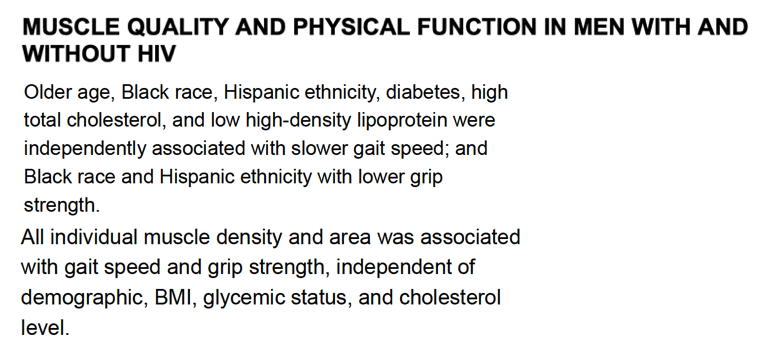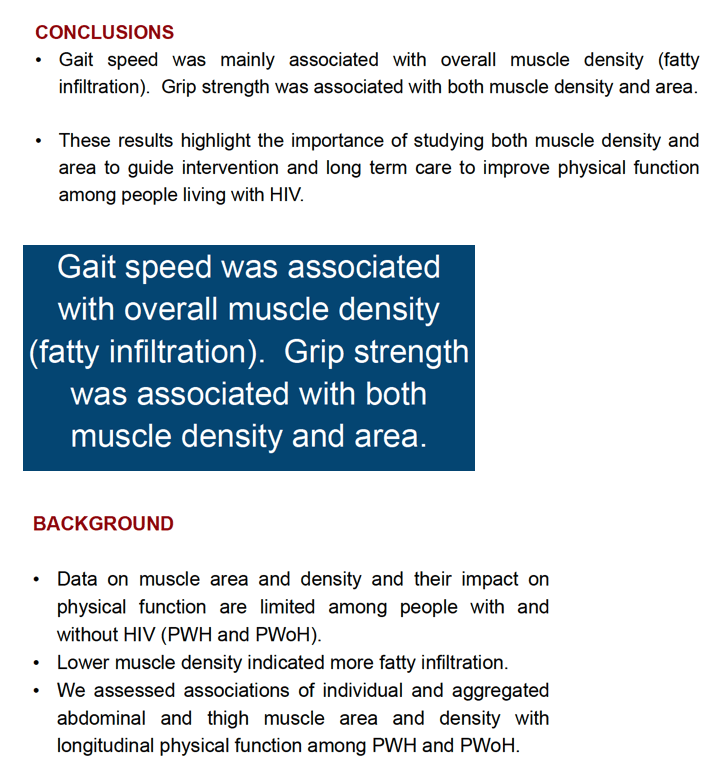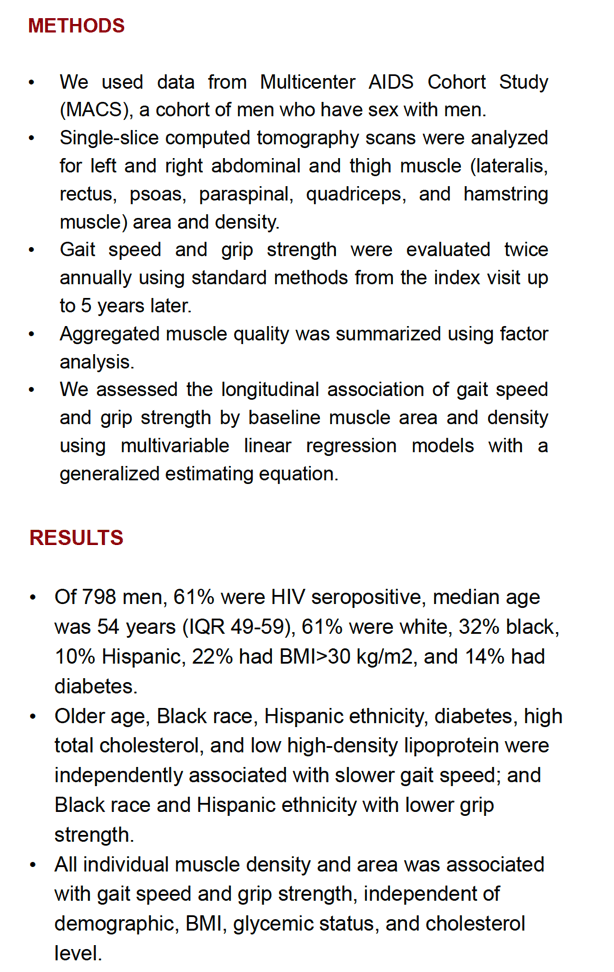 |
 |
 |
| |
MUSCLE QUALITY AND PHYSICAL FUNCTION IN MEN WITH AND WITHOUT HIV
|
| |
| |
CROI 2022 Feb 11-16
see below for poster report
Download the PDF here
------------------------------------------
Differences in Muscle Quantity and Quality by HIV Serostatus and Sex
Feb 17 2022, J Frailty. K.M. Erlandson 1, S. Langan 2, J.E. Lake 3, J. Sun 2, A. Sharma 4, S. Adrian 1, A. Scherzinger 1, F. Palella 5,
L. Kingsley6, S.J. Gange2, P.C. Tien7,8, M.T. Yin9, T.T. Brown10
In summary, older adults with HIV may have smaller and less dense muscles, particularly the psoas, compared to demographically similar older adults without HIV. Differences by sex are apparent, though may be due to differing demographic factors of the two cohorts. These changes in muscle quantity and quality can have important implications on physical function with aging. The longitudinal associations of muscle area and density with physical function require careful investigation, with a particular focus on characteristics and interventions that can preserve muscle area, density, and function over time.
In this large, well-characterized cohort of men and women with and without HIV, we explored the associations of HIV serostatus on both trunk and thigh muscle area and muscle density. Positive HIV serostatus was associated with smaller, less dense psoas but slightly larger and leaner thigh muscles.
Women, regardless of HIV serostatus, tended to have smaller, less dense trunk and thigh muscle. Furthermore, many of these measures of muscle quantity and quality had functional implications among women and men, with and without HIV.
PWH also appear to experience faster declines in functional measures of aging, such as gait speed and grip strength (1, 2). Although decline in physical function can be multifactorial, age-related loss of skeletal mass is a significant contributor to functional decline. Indeed, among PWH, aging is associated with greater than expected declines in lean mass (a proxy for skeletal muscle mass) (3, 4), and lower lean mass has been associated with poorer physical function in multiple cohorts (5-7).
With aging, muscle quality tends to decline before loss of muscle mass (quantity) (8-11). Thus, in addition to changes in the quantity of skeletal muscle, the quality of the muscle may provide a similar or better estimate of subsequent complications (12), including physical function impairment and falls. Muscle quality has been defined in many studies by the amount of fat deposition within muscle, as measured by the Hounsfield unit (HU) density on CT scan. Multiple large cohort studies of older adults without HIV have shown strong associations between fattier (lower density) muscle and poor physical function (13), and more hospitalizations (12), falls (14, 15), and fracture (16).
As deposition of fat in visceral and ectopic (hepatic, pericardial) locations may differ by HIV serostatus (17), the quality of muscle may also be affected by HIV and ART. We have previously shown that initiation of ART is associated with a decrease in trunk muscle density, reflecting an increase in fatty infiltration. Whether greater muscle fat in PWH has a similar effect on impaired physical function, independent of visceral adipose tissue, is not well understood. In a cross-sectional study of men with and without HIV, lower thigh muscle area and density correlated with weaker grip strength (18). Among both men and women with HIV, we found that greater trunk (psoas and paraspinal) muscle density correlated with better physical function and among men only, was associated with stronger grip strength (19). Here, we sought to (1) characterize the associations of HIV and sex on both trunk and thigh muscle density and area, and (2) to compare the relationship between muscle density and area on physical function by sex and by HIV serostatus, in an effort to understand mechanisms of impaired physical function.
Abstract
OBJECTIVE: People with HIV (PWH) experience greater declines in both muscle function and muscle mass with aging. Whether changes in muscle quality and quantity with aging differ between men and women with HIV and the implications on muscle function are not established.
DESIGN: In coordinated substudies of the Multicenter AIDS Cohort Study and Women’s Interagency HIV Study, participants completed physical function and falls assessments; total trunk/thigh density, inversely related to fatty infiltration, and area were quantified from computed tomography (CT) scans.
METHODS: Generalized linear models were used to explore variables affecting density/area, and associations between area/density and physical function and falls.
RESULTS: CT scans were available on 387 men (198 PWH) and 184 women (118 PWH). HIV serostatus was associated with greater lateralis, paraspinal, and hamstring area, but lower psoas area and density. Older age and female sex were associated with smaller trunk muscle area and lower density. Both lower muscle area and muscle density were associated with several measures of impaired physical function. The odds of falling were lower with greater hamstring density, but not associated with other measurers of muscle area or density.
CONCLUSIONS: In summary, older adults with HIV appear to have smaller and less dense (fattier) psoas, a key component in truncal stability and hip flexion that could have implications on physical function. The longitudinal associations of muscle area and density with physical function require careful investigation, with a particular focus on characteristics and interventions that can preserve muscle area, density, and function over time.
-------------------------------

CROI 2022 Feb 11-16
Jing Sun1, Todd Brown1, Susan Langan1, Frank J. Palella2, Jordan Lake3, Lawrence A. Kingsley4, Wendy Post1, Kristine M. Erlandson5
1Johns Hopkins University Baltimore, MD, Country, 2Northwestern University, Chicago, IL 3McGovern Medical School, Houston, TX, USA 4University of Pittsburgh, Pittsburgh, PA, USA 5University of Colorado Anschutz Medical Campus, Aurora, CO, USA




|
| |
|
 |
 |
|
|